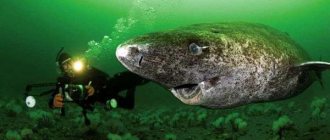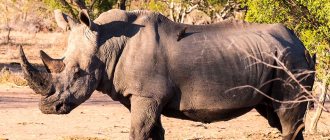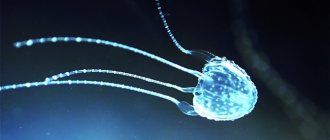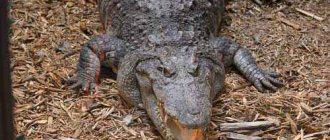- Wild animals
- >>
- Other animals
Cyanea capillata is the largest species of marine jellyfish found on earth. Cyanea is part of one of the "true jellyfish" families. Her appearance is impressive and seems somewhat unreal. Fishermen, of course, think differently when their nets are clogged with these jellyfish in the summer, and when they have to protect themselves by wearing special gear and motorcycle goggles to protect their eyeballs from the cyanea's tentacles. And what do swimmers say when they come across a gelatinous mass while swimming and then notice a burning sensation on their skin? And yet these are living organisms with which we share living space and, despite their originality, they have completely unexpected properties.
Origin of the species and description
Photo: Cyanea
Arctic cyanea rightfully takes first place among jellyfish, as the largest representative of the genus. It is also known as hairy cyanea or lion's mane. The evolutionary history of Cnidaria is very ancient. Jellyfish have already existed for about 500 million years. Cyaneas belong to the Cnidarian family (Cnidaria), which has a total of up to 9,000 species. The most original group is made up of scyphozoan jellyfish (Scyphozoa), numbering about 250 representatives.
Video: Cyanea
Interesting fact: The taxonomy of Cyanea is not completely agreed upon. Some zoologists suggest that all species within a genus should be considered as one.
From the Latin Cyanos means blue and capillus means hair. Cyanea is a representative of the scyphoid jellyfish belonging to the order Discomedusae. In addition to the Arctic cyanea, two other distinct taxa occur in at least the eastern North Atlantic, with the blue jellyfish (Cyanea lamarckii) differing in color (blue rather than red) and smaller size (diameter 10–20 cm, rarely 35 cm) .
Populations in the western Pacific around Japan are sometimes distinguished as the Japanese cyanea (Cyanea nozakii). In 2015, researchers from Russia announced a possible relationship between the species, Cyanea tzetlinii, found in the White Sea, but this has not yet been recognized by other databases such as WoRMS or ITIS.
Aurelia (40 cm)
Aurelia or eared jellyfish is the most common species of invertebrate. The body is shaped like a deep tea saucer with four symmetrical clots at the center and reaches 40 cm. Large jellyfish can be found in southern latitudes, temperate climate zones and in the cold seas of the Arctic. They live in colonies and alone, in coastal areas and at shallow depths. They move slowly: they float up, gathering a dome towards the center, and descend, spreading their numerous tentacles charged with stinging cells to the sides. The poison is not very dangerous and can cause a slight burn. In Asian countries, aurelia is eaten and exotic dishes are prepared from it.
Appearance and features
Photo: What cyanea looks like
Jellyfish are 94% water and radially symmetrical. They have two layers of fabric. The giant jellyfish has a hemispherical bell with jagged edges. The cyanea bell consists of eight lobes, each containing from 70 to 150 tentacles arranged in four fairly distinct rows. Along the edge of the bell is a balance organ on each of the eight notches between the lobes, the rhopalia, which helps the jellyfish navigate. Wide outgrowth oral arms with many burning cells extend from the central mouth. Closer to her mouth, the total number of tentacles increases and is about 1200 pieces.
Interesting fact: One of the most distinctive features of the cyanea is its color. The tendency to form schools is also quite unusual. The jellyfish's extremely efficient nematocysts are its distinguishing feature. Even a dead animal or a severed tentacle can sting.
Some lobes contain sensory organs, including scent pits, balance organs, and simple light receptors. Its bell usually has a diameter of 30 to 80 cm, and some individuals grow to a maximum of 180 cm. The mouth arms are purple with reddish or yellow tentacles. The bell can be pink to reddish-gold or brownish-purple. Cyanea does not have poisonous tentacles along the edge of the bell, but it does have eight groups of 150 tentacles at the bottom of the umbrella. These tentacles contain very effective nematocysts, just like the upper surface of the jellyfish.
The body of the cyanea consists of two superimposed cell layers, the outer epidermis and the inner gastrodermis. Between them lies a supporting layer containing no cells, the mesogloe. The stomach mainly consists of a cavity. It finds its continuation in an extensive system of channels. There is only one opening on the outside, which also serves as the mouth and anus. In addition, fine nerve networks are known, but there are no real organs.
Portuguese man of war (25 cm)
A strange jelly-like creature called the Portuguese man-of-war or physalia lives in all parts of the world's oceans. This jellyfish-like siphonophore is a 25-centimeter sailboat-shaped bubble with long filaments of tentacles reaching 50 m. It looks very attractive, there are blue and purple varieties of physalia. All of them are poisonous.
The substance contained in the tentacles burns, causing acute pain, and paralyzes nerve cells. It is difficult for a swimmer who finds himself in a colony of siphonophores to escape from burns. If help does not arrive, the person will die. The gelatinous bubbles of Portuguese man-of-war are visible from afar; they stay on the surface and wrap their tentacles around their prey.
Where does cyanea live?
Photo: Cyanea jellyfish
The cyanea's range is limited to the cold, boreal waters of the Arctic, North Atlantic and North Pacific Oceans. This jellyfish is distributed in the English Channel, Irish Sea, North Sea and western Scandinavian waters south of Kattegat and Øresund. It may also drift into the southwestern Baltic Sea (where it cannot breed due to low salinity). Similar jellyfish - which may be the same species - are known to live in the seas near Australia and New Zealand.
Fun Fact: The largest recorded specimen, found in 1870 on the shores of Massachusetts Bay, had a bell 2.3 meters in diameter and tentacles 37 meters long.
Cyanea jellyfish have been observed for some time below 42°N latitude in large bays along the east coast of the United States. They are found in the pelagic zone of the ocean as jellyfish, and as polyps in the benthic zone. No specimens have been found that can survive in fresh water or estuaries, as they require the high salinity of the open ocean. Cyanea also does not take root in warm waters, and if it finds itself in milder climatic conditions, its size does not exceed half a meter in diameter.
The long, thin tentacles that emanate from the bell subzone are characterized as "extremely sticky." They also have stinging cells. The tentacles of larger specimens can stretch up to 30 m or more, with the longest known specimen, washed ashore in 1870, measuring 37 m. The cyanea's unusual length—longer than the blue whale—has earned it status as one of the longest known animals in the world. world.
Giant in the sea
The hairy cyanea is the largest jellyfish in the whole world. This is a real giant of the seas and oceans. Its full name is Cuanea arctica, which translated from Latin sounds like “Arctic cyanide jellyfish.” This beautifully glowing pink-violet creature can be found in the high latitudes of the Earth’s northern hemisphere: the jellyfish is common in all northern seas flowing into the Pacific and Atlantic oceans. You can see it directly near the shores, in the upper layers of the water. Researchers who studied the hairy cyanea initially looked for it in the Azov and Black Seas, but never found it.
What does cyanea eat?
Photo: Hairy cyanea
Cyanea pilosa is an insatiable and successful predator. It uses a huge number of its tentacles to capture prey. Once the food is captured, the cyanea uses its tentacles to bring the prey to its mouth. Food is digested by enzymes and then distributed through a system of branched channels in the body. Nutrients are distributed along radial channels. These radial canals provide the jellyfish with enough nutrients to move and hunt.
The animals live in small flocks and feed almost exclusively on zooplankton. They catch prey by spreading out like a screen and slowly descending to the ground. This is how the little crabs get caught in their tentacles.
The main prey of cyanea are:
- planktonic organisms;
- shrimps;
- small crabs;
- other smaller jellyfish;
- sometimes a small fish.
Cyanea catches its prey by slowly plunging, spreading its tentacles in a circle, forming a kind of trapping net. The prey is caught in the "net" and is stunned by the nematocysts that the animal injects into its prey. It is an outstanding predator that is feared by many marine organisms. One of the favorite dishes of Cyanea is Aurelia aurita. Another very important organism that consumes cyanea is ctenophora.
Ctenophores attract attention because they destroy zooplankton in local communities. This has horrific side effects on the ecosystem as a whole. Another interesting food of cyanea is Chaetomagnathae. These sea archers are skilled predators in their own way. The next victim of the jellyfish is Sarsia, a genus of hydrozoan in the family Corynidae. This tiny jellyfish is a good snack for the giant cyanide.
Is the giant creature dangerous?
Large does not mean evil and dangerous. Everything that is said about the danger of this jellyfish is nothing more than a myth. Firstly, encounters between a person and this creature are practically impossible, and secondly, if it stings, only a slight redness will remain from the bite.
loveopium.ru
Cyanea will not cause serious harm to the human body. The maximum that can remain subsequently is local swelling caused by an allergic reaction. If the affected area is large, itching will appear.
Features of character and lifestyle
Photo: Arctic cyanea
Watching live cyanides in the water can be painful as they extend an almost invisible series of tentacles about 3 m long through the water. Hairy jellyfish are constant swimmers that can reach speeds of up to several kilometers per hour and can cover long distances with the help of sea currents. They are known to form kilometer-long schools that can be seen off the coast of Norway and in the North Sea.
Fun fact: Cyanea can be dangerous to swimmers if they come into contact with its tentacles, but it does not prey on humans.
Cyaneas remain mostly very close to the surface, at a depth of no more than 20 meters. Their slow pulsations push them forward little by little, so they depend on ocean currents to help them travel long distances. Jellyfish are most often discovered in late summer and fall, when they have grown to large sizes and coastal waves begin to sweep them ashore. In areas with excess nutrients, jellyfish help purify water.
They absorb energy mainly for movement and reproduction, since they themselves consist of a large amount of water. Consequently, they leave virtually no substance for decomposition. Cyaneas only live for 3 years, sometimes having a life cycle of 6 to 9 months, and they die after reproduction. The polyp generation lives longer. They can produce jellyfish several times and reach several years of age.
Irukandji jellyfish (10 cm)
The 10-centimeter Irukandji jellyfish with meter-long tentacles is more dangerous than a cobra. It lives off the coast of Australia. After a sensitive burn, a severe heart attack, pulmonary edema, stomach cramps, and wild pain throughout the body occur within 20 minutes. They pose a danger to swimmers and fishermen.
Irukandji is named after the Aboriginal people. For a long time, the Indians could not understand what kind of diseases affected them after each trip to sea. When one of the doctors identified the source of the danger, they began to carefully dismantle the nets. The tentacles are covered with stinging cells that produce poison. Any touch causes Irukandji syndrome.
Social structure and reproduction
Photo: Giant cyanea
Like the related umbrella jellyfish, the hairy cyanide changes generations as a tiny polyp that overwinters on the seabed. The peculiarity of hair jellyfish is that their polyp is a perennial plant and can therefore produce young jellyfish repeatedly. Like other jellyfish, cyanides are capable of both sexual reproduction at the medusa stage and asexual reproduction at the polyp stage.
They have four different annual life stages:
- larval stage;
- polyp stage;
- esters stage;
- jellyfish stage.
Eggs and sperm are formed in the form of bags in the projections of the stomach wall. Gametes are transferred through the mouth for external fertilization. In the case of cyanea, the eggs are held in the mouth tentacles until the planula larvae develop. The planula larvae then settle on the substrate and develop into polyps. With each division a small disk is formed, and when several disks have formed, the uppermost one breaks off and floats like an ether. Ephyra evolves into the recognized form of jellyfish.
The female jellyfish carries fertilized eggs in her tentacle, where the eggs develop into larvae. When the larvae are old enough, the female deposits them on a hard surface, where the larvae soon develop into polyps. The polyps begin to reproduce asexually, creating stacks of small creatures called ethers. Individual ephyrae burst into stacks, where they eventually grow into the medusa stage and become adult jellyfish.
Danger to humans
The burn left by cyanide is not life-threatening, although it is quite emotional, allergic reactions are also acceptable. Painful sensations can last up to 8-10 hours, occasionally longer. Jellyfish are mysterious and beautiful representatives of underwater inhabitants, which have been studied by biologists for decades and have not yet revealed all their secrets. It is believed that these creatures lived on the planet even before the dinosaurs appeared, and some of them are immortal. Today the Earth is inhabited by over 2 hundred varieties of jellyfish. Some of them are small, so they often end up in an aquarium and are kept there as pets, while others are so huge in size that they can fit a person in their stomach. The article will discuss the largest of them. It is also called gonionema or “crossed” and is included in the list of poisonous jellyfish. It inhabits the Pacific Ocean and is more often found near the shores of the People's Republic of China and the state of California. The size of the jellyfish is small and reaches 4 centimeters. Its dome is transparent, it has a cross-shaped pattern and about 60 thin tentacles covered with stinging cells. The venom of the cross jellyfish rarely leads to death and only when a person is allergic to it. Basically, it leaves painful burns that are difficult to heal. Irukandji are common inhabitants of the world's oceans, famous for their potent poison, dangerous to humans. When stung by a jellyfish, whose dome size is 10 centimeters, the victim experiences a whole chain of paralytic reactions within half an hour. These include disruption of the gastrointestinal tract, back and muscle pain, pulmonary edema and problems in the functioning of the cardiovascular system. The commonality of these symptoms was called “Irukandji syndrome”. Fortunately, doctors developed an antidote a long time ago, and therefore over the past 20 years the number of deaths from the sting of jellyfish of this species has decreased significantly. Fascinatingly! Some varieties of jellyfish have eyes that provide 360-degree vision. They need them to search for food and identify common enemies. The jellyfish is a beautiful underwater creature, endowed with the ability to emit light shocks when it comes into contact with different surfaces and objects. Often the pelagic nocturnal moth washes up on the coast, which is why the creature glows with multi-colored lights at night. The specificity of jellyfish is the presence of 8 stinging tentacles dotted with poisonous glands. Contact with them causes severe burns that take a long time to heal. Therefore, doctors recommend that those who go on vacation to the Atlantic, Pacific Ocean or Red Sea not to touch speckled jellyfish, the diameter of which does not exceed 12 centimeters. It inhabits the waters of the world's oceans, is often found off the coast of Pakistan and causes a lot of problems for swimmers. The jellyfish, the length of which together with the tentacles reaches 15 centimeters, has a paralytic poison. One bite of alatina alata can cause severe poisoning and lead to death. Small individuals pose a special threat. They are transparent and virtually invisible in the water, which is why a person can touch them and get hurt. It was not by chance that the name of the jellyfish was the Portuguese man-of-war. It is a jelly-like animal that spends most of its life on the water. Her body is a 25-centimeter bubble that continuously floats on the surface of the world's oceans. With its goads, the Portuguese man-of-war attracts small fish, which are later drawn inside its dome. The tentacles of a jellyfish are covered with glands containing paralytic poison. It can cause great damage to human health, and in especially severe cases lead to death. If a swimmer is stung by a Portuguese man-of-war, you should immediately go to the clinic, even if there are no signs yet. Another name for jellyfish is eared jellyfish. It is one of the most widespread invertebrates in the world because it inhabits all the oceans on the planet. The animal is not very active; it swims slowly, squeezing and relaxing its dome. Its tentacles are short, dot the edges of its body and do not contain poison dangerous to humans. The size of aurelia does not exceed 40 centimeters. In Asia, jellyfish are eaten, sometimes raw. However, one must be careful with such an exotic dish; abnormally prepared tea can burn the esophagus or cause bleeding in the stomach. It lives preferably near the coast of Australia; sometimes jellyfish of this species are found near the Philippines, New Zealand, Thailand and Indonesia. It is characterized by a blue luminous 45-centimeter dome and long, thread-thin tentacles. The venom of the sea wasp is so strong that one individual can kill up to 50 people if they do not promptly seek help from a doctor. The exceptional creature that can experience a jellyfish sting is the sea turtle. For them, the venom of the sea wasp is harmless, so they happily eat invertebrates. A beautiful and huge jellyfish that can be found near the continents in the south of the globe. It is also often caught in the nets of fishermen in the Black and Mediterranean Seas. The dome of an adult individual can reach 180 centimeters, and weight - up to 120 kilograms. Roots are useful creatures whose poison is used in medicine to treat various diseases. For humans, an animal bite is harmless. After contact with a jellyfish, a slight burn or blisters may remain on the body. In Japan and Korea, cornmouths are eaten. They are used to make salads or add a gelatinous mass to soups. Fascinatingly! Turritopsis dornii jellyfish are considered immortal creatures by scientists. They can endlessly enter the polyp stage and be born again, and so on until they are eaten by predators. The purple striped jellyfish is a rare species, one that has not actually been studied by biologists. The largest specimen that fell into the hands of scientists weighed about 130 kilograms, and the diameter of its dome was 190 centimeters. The remaining creatures of this species, living off the coast of Southern California, grow up to 70 cm in diameter. So far, doctors have not recorded cases of death from the poison of the purple striped jellyfish, but bites, despite the rarity of the animal, are common. After poisoning, difficult-to-heal blisters and sores form on the skin. An incredibly beautiful and little-studied species of jellyfish, representatives of which have a dome up to 2 meters in size. The bottom of the body of Nomura's bell is studded with thin and wide tentacles, all of which have venom glands. The animals live near the coasts of Japan, China and Korea. They rarely cause damage to swimmers, but often interfere with fishermen. Trapped in a net, Nomura is capable of killing every catch, spraying poison around, and even capsizing a light fishing boat. The largest jellyfish in the world. It is also called the lion's mane, arctic or hairy jellyfish. The length of the tentacles of this animal is about 37 meters, and the diameter of the body (dome) is up to 250 cm. Cyanea is the largest member of the scyphoid family. Its closest relatives are Japanese or blue cyanide. The creature lives in the northern Atlantic and Pacific Oceans, and is sometimes found in Arctic waters. Hairy cyanea does not survive in warm seas, and if this happens, the individual grows up to 50 cm in diameter.
Natural enemies of cyanea
Photo: What cyanea looks like
Jellyfish themselves have few enemies. As a species that prefers cold waters, these jellyfish cannot handle warmer waters. Cyaneas are pelagic for most of their lives, but tend to settle in shallow, sheltered bays towards the end of their life. In the open ocean, cyanea become floating oases for some species, such as shrimp, stromateaceae, rayfish, constipidae and other species, providing them with a reliable source of food and providing protection from predators.
The predators of cyanea are:
- seabirds;
- larger fish such as ocean sunfish;
- other types of jellyfish;
- sea turtles.
The leatherback turtle feeds almost exclusively on cyanide in large quantities during the summer season around Eastern Canada. To survive, she eats the whole cyanea before it has time to mature. However, since leatherback turtle populations are so small, no specific preventive measures need to be taken to reduce the likelihood of the leatherback turtle becoming extinct due to its sheer numbers.
In addition, a fairly common small crayfish, Hyperia galba, becomes a frequent “guest” of the jellyfish. Not only does it use the cyanea as a "vector", but it also consumes food scone in the gutter. Which can lead to starvation of the jellyfish and further death.
Nutrition
Cyanea is a predator, and quite a voracious one at that. It feeds on zooplankton, small fish, crustaceans, scallops, and smaller jellyfish. In hungry years, it can go without food for a long time, but in such times it often engages in cannibalism.
Cyanea floating on the surface resembles a pile of algae , to which fish swim. But as soon as the prey touches its tentacles, the jellyfish sharply releases a portion of poison through the stinging cells, wraps itself around the prey and moves it towards the mouth.
The poison is released over the entire surface and length of the tentacle; the paralyzed victim becomes lunch for the predator. But still, the basis of the diet is plankton, the diversity of which the cold waters of the oceans can boast of.
Cyaneans often gather to hunt in large groups. They spread their long tentacles across the water, thus forming a dense and large living network.
When a dozen adults gather to hunt, they control hundreds of meters of water surface with their tentacles. It is difficult for prey to slip through these paralyzing nets undetected.
Australian sea wasp (45 cm)
A jellyfish called the sea wasp, which mostly lives in the coastal resort area of Australia, is found off the coast of Vietnam, Thailand, Indonesia, Malaysia, Brunei, the Philippines, and New Zealand. It is considered the most dangerous for humans. A 45-centimeter dome, 60 tentacles that stretch up to 3 meters long during hunting, 24 eyes are the distinctive features of the deadly giant.
A person's heart paralysis occurs within a minute from a burn. When colonies appear a short distance from the coast, the beaches are closed. The poison of one oma can kill up to 60 people; the tentacles of a dead jellyfish remain poisonous for two weeks. But sea turtles are not afraid of poison. They enjoy the gelatinous mass with pleasure.
Medusa Chrysaora (1 m)
In third place in the ranking of the largest jellyfish in the world is the Golden Chrysaora or sea nettle. This is a meter-long giant that continues to grow throughout its life. Externally, the chriasora resembles a lady's hat with ties and a veil, striking in color and clear shape. Numerous tentacles hanging from the edges of the tentacle reach 5 meters in length. They are collected in 8 groups, located symmetrically.
The poison contained in stinging cells is similar to nettles: burns pass quickly and leave no traces. These large jellyfish are found on the eastern and western Pacific shelves from Canada to Mexico. The jelly-like creature is named after the mythological Chrysaor, the son of the Gorgon and Poseidon.











